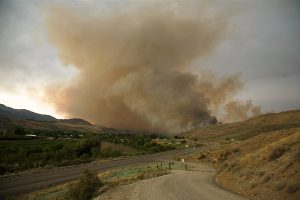The Washington Department of Labor and Industries is developing a wildfire smoke standard. The department acknowledged receiving a petition to initiate a rulemaking for wildfire smoke exposures.
The Labor and Industries department also pointed to California’s emergency temporary standard for wildfire smoke as a possible model for its own rule.
Issues to be addressed in a wildfire smoke standard would include:
- Identification of harmful exposures to smoke from wildfires;
- Communication of hazards;
- Training and information for employees; and
- Control measures, including possible respiratory protection, for harmful exposures.
The agency acknowledged that it recognizes that the hazard of wildfire smoke exposure is increasing every year and that that hazard now poses occupational health risks to all outdoor workers, especially those in agriculture and construction.
The Labor and Industries department pointed out that employers and workers in regions affected by wildfires must understand the hazards presented by wildfire smoke and wildfire cleanup activities. Smoke from wildfires contains chemicals, gases, and fine particles that can harm worker health.
Health hazards continue even after fires have been extinguished and cleanup work begins, according to the state. Proper personal protective equipment (PPE) and training are essential for worker safety in wildfire regions.
The state asked that parties interested in the development of wildfire smoke rules contact their administrative regulations analyst. The public will be offered an opportunity to comment after amendments to the occupational health standards have been proposed.
During this past summer’s fires, the department’s Division of Occupational Safety and Health (DOSH) issued a hazard alert regarding wildfire smoke and the use of dust masks during the COVID-19 pandemic. Whether a worker should wear a dust mask—a filtering facepiece respirator (FFR) such as a KN-95 or an N-95 with exhalation valves—depends on an area’s air quality as measured by the EPA’s Air Quality Index (AQI).
An N-95 respirator has approval from the National Institute for Occupational Safety and Health (NIOSH) for use in a respiratory protection program. KN-95 respirators are produced by foreign manufacturers and lack NIOSH approval. The Centers for Disease Control and Prevention (CDC) and the U.S. Occupational Safety and Health Administration (OSHA) have temporarily allowed the use of foreign-made FFRs in healthcare facilities to alleviate respirator shortages during the coronavirus disease 2019 (COVID-19) pandemic.
For physically exertive outdoor work while the AQI is 151 to 499, employers may allow the voluntary use of KN-95s and N-95s with exhalation valves, but a voluntary program must include training on donning and doffing and performing user seal checks. Medical evaluations and respirator fit testing are not required for voluntary use of FFRs when used for wildfire smoke.
When the AQI reaches or exceeds 500, employers must implement a required-use respiratory protection program with the use of NIOSH-approved dust masks or respirators. A required-use respiratory protection program must comply with all the state’s requirements for a written program, including medical evaluations, fit testing, training, and recordkeeping.
If the Washington standard is modeled on California’s regulation, it could include requirements that employers:
- Train employees on the health effects of wildfire smoke and proper use and maintenance of respirators.
- Identify harmful exposures to airborne particulate matter from wildfire smoke before each shift and periodically during shifts by checking the AQI for particulate in areas where workers are located.
- If feasible, reduce harmful wildfire smoke exposures by relocating workers to an enclosed building with filtered air or to an outdoor location where the AQI is lower.
- Provide respirators for voluntary use if an employer cannot reduce workers’ exposures to wildfire smoke so that the AQI for particulate matter is 150 or lower.
- Provide mandatory respiratory protection if the AQI exceeds 500.

